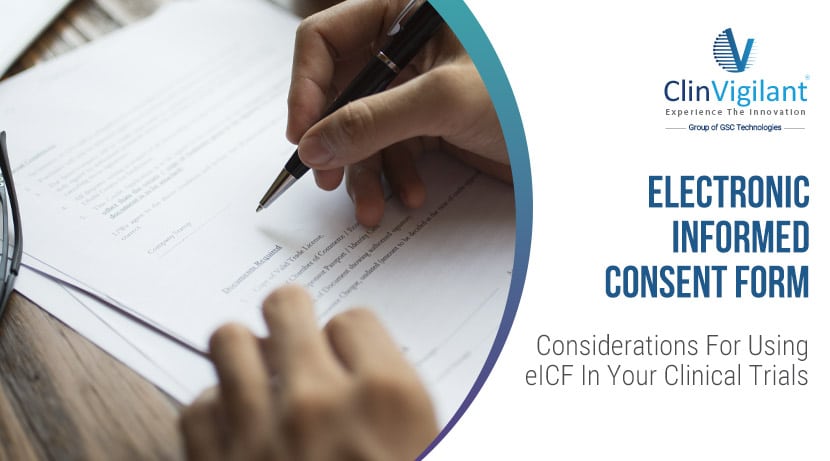Electronic Informed Consent Form
Informed consent is a critical part of any clinical trial to ensure participants understand the details of the study before volunteering. Traditionally, this has been captured via paper informed consent forms. However, technology now allows clinical trials to implement electronic informed consent forms (eICFs) as an alternative approach.
If you’re considering using eICF for an upcoming clinical trial, there are some key factors to take into account to ensure it’s implemented successfully. This article will provide an overview of eICFs, how the electronic consent process works, regulatory considerations, and the various advantages and disadvantages of using an electronic system versus the traditional paper method.

What is an Electronic Informed Consent Form (eICF)?
An electronic informed consent form, or eICF, is the digital version of the traditional paper document. It contains the same information regarding the clinical trial goals, procedures, risks, and benefits. The key difference is it’s provided through an electronic system and incorporates features like videos, animations, slide shows, and Knowledge checks to enhance participant understanding.
Once the individual has reviewed the study details, they can electronically sign the legally binding eICF with a stylus, mouse, or touchscreen instead of a paper document. Their signature and the date/time are recorded in the system.
How does electronic consent work?
The electronic consent process contains two key components – the study information page and the signature page:
Electronic study information page
The study information page contains a digital version of content typically found in a paper consent form. This includes summaries, graphics, images, videos and more to engage users and simplify complex concepts. Embedded knowledge checks confirm understanding as they go through the information.
All content is broken down into easily digestible sections that participants can review at their pace. Links allow toggling to different sections to reinforce understanding of study details including potential risks, benefits procedures and more.
Electronic signature
Once a participant finishes reviewing the online study details, they arrive at the signature page. This collects all required signatures to legally document informed consent electronically instead of on paper.
There are security checks like password protection and encryption to ensure authenticity and prevent tampering. The system also records an indelible audit trail capturing signing date, time, and more for additional verification.
Facilitate understanding of electronic consent
Switching participants from paper to electronic informed consent introduces a change in process that requires some adjustments.
It can help ease this transition by:
- Allowing both paper and electronic consent options initially
- Providing demonstrations of the eICF process and system
- Answering any questions on how the electronic consent works
This gives participants options as they get accustomed to the digital method. It also reinforces understanding so individuals feel more comfortable using the electronic system.
Answering technical questions
Despite enhancements like videos and quizzes, some patients may still have questions on how to use an electronic system for consenting.
It’s important study staff are well versed on the eICF system and process. This allows them to walk participants through electronically signing the form, navigating different pages, and use of styluses or touch screens for signatures.
Quickly answering any technical or procedural questions ensures patients understand how to provide consent digitally vs. paper method they may be more familiar with.
Identity verification for electronic consent
A key concern with electronic consent is verifying participant identity remotely to prevent fraud. Steps to consider include:
Credential checks: Require entry of unique study ID numbers, site access codes or other credentials to verify identity and prevent unauthorized access.
Audit trails: As highlighted earlier, indelible digitized audit trails record user, date/time stamps, and digital IP addresses to authenticate users.
Video conferencing: Scheduling a video conference with the participant to visually validate their identity against supplied study documents.
ID verification questions: Use a third-party identity verification system that asks users personal questions only they can answer correctly before granting access to the eConsent form.
Regulations and electronic consent
While offering advantages, it’s vital eICF in clinical research meet regional regulations and guidelines governing clinical study informed consent such as 21 CFR Part 11, HIPAA compliance, EU Annex 11 and more.
Key requirements include strict security protocols, standardized terminology, indelible audit trails recording user name/ID, date/time stamps and more.
Staying abreast of latest guidance as regulations evolve for eConsent ensures your trials remain compliant.
Advantages of electronic consent for participants
Electronic informed consent delivers multiple advantages for clinical trial volunteers:
Convenience: Participants can review study details and sign consent forms anytime, anywhere from mobile devices. This avoids trips to study sites.
Simplicity: Content broken into simple sections, embedded quizzes, graphics and videos simplify complex medical concepts for better understanding.
Accessibility: Features like videos with closed captioning and screen readers to translate text to audio makes study information more accessible for those with vision, hearing or learning difficulties.
Engagement: Interactive content keeps patients more engaged as they learn study information.
Asking questions: Tools like chatbots or live chat help participants easily clarify consent details before signing.
Advantages of electronic consent for investigators
Electronic systems also offer multiple advantages from the researcher perspective:
Time savings: Automated processes reduce time spent on consent procedures via eliminating paper handling.
Error reduction: System safeguards lower risks for human errors like missing signatures.
Ease of retrieval: Instant access to digitized, searchable records simplifies audits.
Remote capabilities: Enables obtaining consent remotely from patients when in-person visits are difficult.
Participant analytics: Detailed analytics tracking reviewer time spent on each section, content accessed, quiz results and more provides insights into consent process effectiveness.
Are You Planning To Have An Electronic Consent Form For Your Clinical Trials?
The benefits highlighted make a compelling case for switching from paper to eConsent processes. However, careful planning is vital before implementation.
Be sure to assess factors like technical readiness, staff training needs to support participants, and inclusion of system validation and testing periods. Building lead time for deployment, refinement and stabilization ensures smooth adoption.
Also, consider phased roll-outs starting with smaller pilot studies before scaling across all trials. This allows working out any issues on smaller levels first.
Finally, have a backup plan allowing reverting to paper consent if necessary during initial periods.
Conclusion
Informed consent in research is a critical aspect of ethical clinical trials to safeguard participant rights and interests. Electronic solutions enhance this process through simplified study information and easy electronic signatures.
However, careful planning around deployment, training, validation testing and phased rollouts is vital to ensure successful adoption. But once in place, eConsent’s advantages around improved understanding, convenience, efficiency and oversight justify considering this approach for your next trial.
Frequently Asked Questions
Q: Is electronic consent as legally valid as paper consent forms?
A: Yes – electronic informed consent for clinical trials is equally legally valid and binding as long as it meets regulatory requirements including digital signature capture, identity verification, security protocols, and detailed audit trails.
Q: What training is required for staff to facilitate participant eConsent?
A: Staff assist patients through the eConsent process by demonstrating use of devices, navigating system pages, clarifying information, and fielding technical questions. Proper training ensures they can support the participant successfully transition from paper to digital consent.
Q: How does use of videos and graphics help improve informed consent?
A: Studies show incorporating videos, animations, 3D models and other multimedia tools boosts patient comprehension of clinical trial information versus text alone. Using multiple formats improves understanding which translates to better informed consent.
Are Your Planning To have An Electronic Consent Form For Your Clinical Trials?
ClinVigilant provides end-to-end digital solutions for your clinical trials which includes eTMF, eICF, Patient Engagement, EDC tools, and many more. Provide the details below to connect with our expertise team and explore our digital services.

